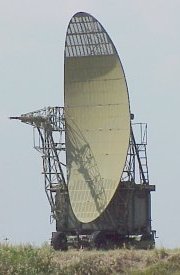Height finder

Figure 1: PRW-17 „Odd Group”
Height finder
A height-finder is an older one ground-based type of 2-dimensional radar that measures the elevation angle and estimates the altitude of a target. The antenna pattern of a height-finder radar is a fan beam, quite narrow in azimuth but still much narrower in the elevation angle. The entire antenna of the altitude finder radar is moved mechanically up and down, in a nodding movement, which led to it also being called nodding radar.
The display type is of range-height indicator (RHI) using a sectoral scope with a polar coordinate system.
Height finders usually work in conjunction with an air surveillance radar using a rotating antenna. They get a target assignment, rotate with a handwheel manually its antenna in the desired direction and measures the elevation angle of this one target. Sometimes, the height-finder can also rotate synchronously with the surveillance radar and contribute to the image on the plan position indicator (PPI) by covering a specific height angle. Its echo signals are additionally displayed on the PPI-scope of the surveillance radar if the rotation between the two radar sets is synchronized.
With the introduction of 3D radars, these altitude height-finders have lost their importance.

